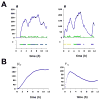Nucleosome retention and the stochastic nature of promoter chromatin remodeling for transcription
- PMID: 18485878
- PMCID: PMC2409070
- DOI: 10.1016/j.cell.2008.02.051
Nucleosome retention and the stochastic nature of promoter chromatin remodeling for transcription
Abstract
The rate-limiting step of transcriptional activation in eukaryotes, and thus the critical point for gene regulation, is unknown. Combining biochemical analyses of the chromatin transition at the transcriptionally induced PHO5 promoter in yeast with modeling based on a small number of simple assumptions, we demonstrate that random removal and reformation of promoter nucleosomes can account for stochastic and kinetic properties of PHO5 expression. Our analysis suggests that the disassembly of promoter nucleosomes is rate limiting for PHO5 expression, and supports a model for the underlying mechanism of promoter chromatin remodeling, which appears to conserve a single nucleosome on the promoter at all times.
Figures







References
-
- Adkins MW, Howar SR, Tyler JK. Chromatin disassembly mediated by the histone chaperone Asf1 is essential for transcriptional activation of the yeast PHO5 and PHO8 genes. Mol Cell. 2004;14:657–666. - PubMed
-
- Bar-Even A, Paulsson J, Maheshri N, Carmi M, O’Shea E, Pilpel Y, Barkai N. Noise in protein expression scales with natural protein abundance. Nat Genet. 2006;38:636–643. - PubMed
Publication types
MeSH terms
Substances
Grants and funding
LinkOut - more resources
Full Text Sources
Other Literature Sources
Molecular Biology Databases

